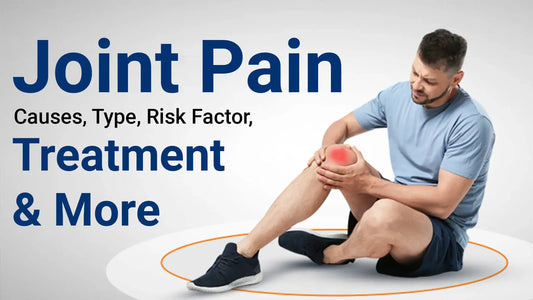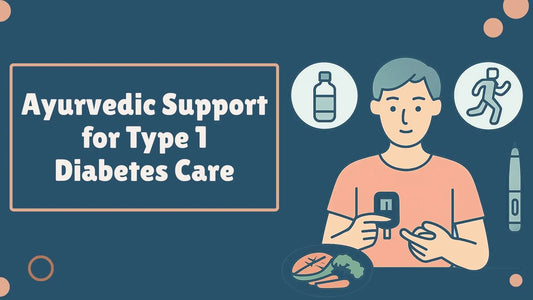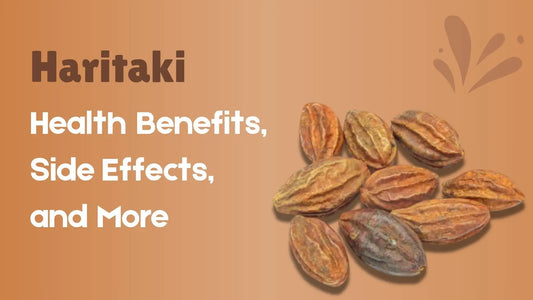
Joint Pain: Causes, Type, Risk Factor, Treatment and More
Joint pain is a common issue that people of all ages can experience due to different reasons. It can be due to a deficiency of vitamin D, magnesium, and calcium, or, in some cases, when fluids get collected in the joint or owing to cartilage degeneration arising from injury or increasing age. In other words, it is arthralgia, which may or may not be inflamed and accompanied by warmth or swelling.
Joint pain is harmless only when managed well. Before a small back pain turns into a severe issue, you need to tackle it well. In Ayurveda, there are various treatments available that can help you manage it naturally without relying on medications. Let’s talk in detail, joint pain causes, types and various natural solutions to deal with it.
Understanding joint pain better
Your joint is a crucial functioning part of your body. It is the meeting point of two bones. It might be a matter of concern if the joints become swollen, inflamed, and stiff. You may find it difficult to move that specific joint and experience discomfort in your body.
That's what joint pain is, and it might weaken your muscles, ligaments, and tendons, thus affecting your movement. Joint pain is commonly experienced around the knees, neck, shoulder and back.
Common Symptoms of Joint Pain

When there is a loss of cartilage, joints rub against each other and make the person’s life difficult.
Some of the common symptoms of joint pain are:
-
Enlargement of joints.
-
Swelling, redness in the affected area.
-
Irritation during movement.
-
Experiencing difficulty flexing joints.
-
Lack of mobility.
-
Experiencing clicking, clapping, and grinding sounds while moving.
Joint Pain Causes – It’s Not Just About Old Age!
There is no single definite reason behind joint pain causes. Though there is an increasing possibility of experiencing it in older age. Other reasons why you might experience joint pain are-
Arthritis:
It is a joint inflammatory condition that weakens the articular cartilage or causes the accumulation of fluids around the surrounding tissues. It also weakens the tendons and muscles, thus hurting your joints.
Osteoarthritis:
It is a long-term joint condition wherein the protective cartilage that cushions the ends of your bones gradually wears down over time. This affects the movement of joints, making it difficult to walk smoothly.
Rheumatoid Arthritis:
In this condition, the synovial fluid becomes a toxic fluid and goes on to weaken the joints and associated tissues. Thus making it painful to move joints freely.
Gout:
It occurs due to the accumulation of uric acid in the joints and can cause swelling and inflammatory gout. This can make anyone go through a painful experience of having swollen and painful joints.
Dosha Imbalance:
As per Ayurveda, joints can also hurt when Vata dosha gets aggravated. It can lead to dryness, stiffness, and cracking sensations in joints known as Sandhivata. Arthritis in Ayurveda comes in different forms: Sandhivata, Amavata, and Vatarakta, triggered by Vata, kapha and pitta imbalance.
Injuries:
Falling from the bicycle, suffering from an accident, or getting hurt in any outdoor sports, let’s say cricket, football, tennis, or even swimming or diving, may bring the following challenges to your joints, such as Sprains and strains, dislocations and fractures.
Overuse:
Repeated movements of the joints in a specific area may weaken your joints and affect the surrounding muscles, tendons, and ligaments. Thus hurting your joints.
Infections:
The body might respond to the infection severely, which might further slow down the flow of blood to the joints, making it difficult for the joints to move freely.
Other joint conditions:
Tendinitis
Fibrous tissues get inflamed, which might connect the bones and muscles.
Bursitis
It degenerates the natural thickness of muscles with the progression of pain, swelling, and stiffness.
Lupus
It is another form of arthritis that happens to attacks its cells and may lead to serious health disorders affecting the kidneys, brain, lungs, and heart.
Fibromyalgia
It is a form of weakness, pain, and swelling that might arise owing to severe tiredness, sleep disorders, and memory disorders.
Cancer (rare)
It is identified in the form of a lump or swelling near the joints, which may damage the surrounding tissues.
You can also experience joint pain as a result of a weak immune system, weak tissue conditions, immobility, and discomfort.
Types of Joint Pain

Here are the types of joint pain that you may be experiencing. Understanding each type can help you manage it better.
Ankylosing spondylitis
In this condition, repeated bending or movement, or sitting in one place, might affect the spine and surrounding tissues with stiffness, inflammation, and pain. That specific portion of the body makes the person suffer from unbearable pain and inflammation.
Gout
A person with this type of joint pain is found to suffer from intense pain, inflammatory sensations, and swelling due to a collection of uric acid in the joints. This type of joint pain has been noticed in diabetic people.
Juvenile idiopathic arthritis
These inflammatory conditions in the joints may surface for a short period or may last for a lifetime in teenagers or younger children. Neglecting such a kind of arthritis may lead to different complications in the body.
Osteoarthritis
Osteoarthritis is a type of joint pain that deteriorates the cartilage in the joints, thereby increasing the conditions of stiffness, swelling, and immobility.
Psoriatic arthritis
Psoriatic arthritis is a form of arthritis that affects the body of any person who suffer from red patches on the skin that cause itching sensations.
Reactive arthritis
This form of arthritis can be recognised by constant pain in any part of the body, which may be an organ or joints, weakening any other joints, or spreading pain in specific joints.
Rheumatoid arthritis
It is the increase in inflammatory fluid in the joints that causes swelling. Pain and difficulty in movement. Rheumatoid arthritis makes the person tired and stressed after a little mobility.
Septic Arthritis
Due to any form of injury, toxicity, or infection, it reaches the joints and raises inflammatory conditions. This form of arthritis has been observed more in children and must be taken seriously care of.
Thumb arthritis
This type of arthritis or joint pain tends to target elderly people. The cartilage wears down at the base of the thumb and causes inflammatory and stiff conditions.
Treatments for Joint Pain
Ayurvedic solutions have been adapted since ancient times, due to their efficiency in treating joint pain naturally.
1. Use these Ayurvedic Herbs for Joint Pain relief
The benefits of Ayurvedic herbs are many, not just for joint pain but for overall well-being too. Let’s understand some of the herbs that can give you joint pain relief.
Turmeric
Consuming turmeric as a part of culinary cuisine or as a supplement will help reduce inflammatory joint pain conditions.
The presence of curcumin in turmeric helps in removing the toxins accumulated in the joints.
Ashwagandha
Ashwagandha, with its high rate of adaptability, happens to reduce stress levels.
One can consume it in the form of tea or a supplement to reduce the discomfort and inflammatory conditions in the joints.
Boswellia
Its effectiveness in altering the inflammatory response in the joint happens to be sourced from boswellic acid.
Anyone suffering from osteoarthritis or rheumatoid arthritis can have a steady recovery and gain strengthened immunity without experiencing any side effects.
Ginger
People have experienced an improvement in their joint pain conditions by consuming tea enriched with ginger.
The impact of gingerol in ginger may counter the discomfort and painful situations in the joints.
Guggul
It is capable of controlling cartilage degeneration and triggering lubrication in joints.
It increases flexibility and elasticity in the joints with its resin-like properties, which are extracted from the bark or stem of a specific plant.
2. Regularly massage with Ayurvedic Oil
Massage your affected areas with Dhurandar joint pain oil. This oil is the most effective solution for managing all types of joint pain due to its herbal formulation. All natural herbs work towards giving you relief from the constant pain in the long term. You can apply it twice a day. For better results, consider applying before sleep.
3. Practice these Yoga techniques for Joint Pain Relief
Doing yoga for joint pain relief can be a beneficial option. Poses like Utthita Parsvakonasana, Setu Bandhasana, Cat-Cow Pose, Bridge Pose, Virabhadrasana, Dhanurasana, Low Lunge, Seated Spinal Twist, and Chair Pose may help relieve joint pain.
These yoga poses not only aid in joint pain relief but also enhance your overall health and well-being.
Apart from adapting to these treatments, you should also be cautious of the foods you are including in your diet. Include some healthy foods such as nuts, seeds, and leafy greens in your diet. Avoid consumption of these foods to prevent your pain from getting aggravated if you have arthritis or other joint pain conditions.
Conclusion
Joints tend to get inflamed with increasing age, a weak immune system, obesity, and a deficiency of nutrients. All these factors contribute towards giving you pain in the joints. In most cases, elderly people are affected, and sometimes, children and teenagers go through serious arthritis problems like juvenile and septic arthritis. It’s therefore necessary to be cautious to prevent your joints from any of these issues. Whatever the joint pain cause is, you can prevent it by adapting to the Ayurvedic lifestyle changes and avoiding such activities that can worsen your condition.
Joint Pain FAQs
Q1. What causes joint pain?
Ans: Joint pain causes vary from individual to individual. Common reasons include arthritis, injury, Osteoarthritis, dosha imbalance and infections.
Q2. Will joint pain go away by itself?
Ans: It depends on the severity of your condition. Sometimes, mild joint pain from overuse or minor injuries can go away with rest and self-care. But if the pain is persistent, severe, or caused by conditions like arthritis, it likely won’t go away on its own and needs proper treatment.
Q3. How can I fix joint pain?
Ans: If joint pain is mild, you can fix it with some home remedies through oil massages or by taking care of yourself through a healthy diet and lifestyle changes. Try focusing on a natural diet rich in fruits, vegetables, ghee, fish, eggs and wholegrains and a light to medium level of exercise. However, if your condition is severe and not managed by these remedies, then it is always better to consult a doctor to recover from joint pain.
Q4. What are some symptoms of joint pain?
Ans: Joint pain can be identified by redness, swelling and consistent pain in the affected area. It can also create difficulty in moving freely.
Q5. Where is joint pain felt?
Ans: Joint pain is usually felt right at the joint, at the place where two bones meet, like in the knees, hips, elbows, shoulders, or fingers. Depending on the type of joint pain, it might stay in one area or move around to different joints.
References
- Natura G. Joint pain [Internet]. ResearchGate; [cited 2025 Apr 24]. Available from: https://www.researchgate.net/.../Joint-pain.pdf
- Neogi T. Clinical significance of bone marrow edema lesions in osteoarthritis: a systematic review. Arthritis Res Ther [Internet]. 2009;11(6):R229. Available from: https://link.springer.com/.../ar2069.pdf
- Latimer J, Finlay S. 'Not just about joints': arthritis, medication and meanings. Sociol Health Illn [Internet]. 2014;36(7):1008–22. Available from: https://onlinelibrary.wiley.com/.../12248
- Vina ER, Kwoh CK. Epidemiology of osteoarthritis: literature update. Curr Opin Rheumatol [Internet]. 2018;30(2):160–7. Available from: https://www.sciencedirect.com/.../S1063458418300827
- Nikbakht A, Mohammadi F. The effect of applying hot and cold compress on pain intensity and quality of life in patients with knee osteoarthritis. Iran J Nurs [Internet]. 2016;29(103):50–9. Available from: https://www.sid.ir/.../5071520160308.pdf
- Swain S, Sarmanova A, Coupland C, Doherty M, Zhang W, Hall M, et al. Comorbidities in osteoarthritis: a systematic review and meta-analysis of observational studies. Medicines (Basel) [Internet]. 2020;7(11):67. Available from: https://www.mdpi.com/.../67/pdf

Dr. Pooja Verma
Dr. Pooja Verma is a sincere General Ayurvedic Physician who holds a BAMS degree with an interest in healing people holistically. She makes tailor-made treatment plans for a patient based on the blend of Ayurveda and modern science. She specializes in the treatment of diabetes, joint pains, arthritis, piles, and age-related mobility issues.



